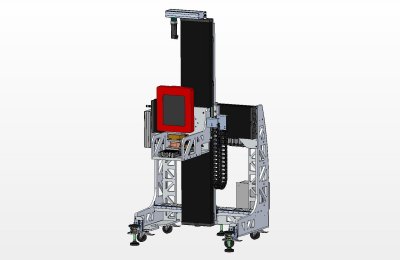Platform for Detector Technology and Systems
The Helmholtz Association is creating a platform to develop detector technology and detector systems further. The aim of the platform is to advance technologies for the construction of highly integrated detectors of photons, neutrons and charged particles, to optimise the transmission and evaluation of data and to design and build new detector prototypes.

The mobile detector portal for the HEMS Beamline by DESY was developed in the technical institute of the HZG. The detector producing high data rates can be used with high precision in three dimensions. Photo: HZG/Technikum
The know-how of seven Helmholtz Centres and two Helmholtz Institutes as well as presently eleven universities and seven further research institutions from Germany and abroad is being combined for this project. The platform is being funded with 13m euros as a portfolio topic from 2012 to 2016.
“Highly sensitive detectors are not only needed in fundamental research but more and more also in applied research, such as the development of new materials, and for medical research”, explains Professor Dr. Jürgen Mlynek, president of the Helmholtz Association. Therefore, the Helmholtz Association is funding the new platform for detector technologies and detector systems, in order to systematically strengthen the co-operation between research institutions and universities in this area and achieve faster progress.
For this reason, the Helmholtz Association is investing 13m euro in development funds until 2016, subsequently the research work will be continued within the research programme of the Helmholtz Community. The coordination lies with the Institute for Technology in Karlsruhe (KIT), a further six Helmholtz Centres contribute their expertise, amongst them also the Helmholtz-Zentrum Geesthacht. In addition, the two Helmholtz Institutes in Jena and Mainz are involved and, so far, seven further research institutes and eleven university from Germany and abroad. The coordinating spokesperson is Professor Dr. Marc Weber of the KIT.
The detectors of the future will be by far more sensitive than today’s detectors and supply a new scale of data. For some tasks detectors are needed which have the size of a block of flats, e.g. in elementary particle physics at the Large Hadron Collider (LHC) at CERN. Other detectors, by contrast, are even extremely small, so that they can be inserted into the human body with an endoscope and make non-invasive medical examinations possible.
The new platform guarantees public access to the latest detector technologies and to the detectors based on these techniques and demonstrates the German expertise in this area on an international level. The project will also facilitate the universities’ participation in research projects of the Helmholtz Association and makes the Centres’ infrastructure available for them. The training and support of the next generation of scientific-technical experts in the field of detector instrumentation is another essential objective of the detector initiative.
At the German Engineering Materials Science Centre” (GEMS), the Helmholtz-Zentrum Geesthacht offers research facilities for external users who require detector technology. Some of the detectors that are used at the GEMS instruments were developed and built by engineers at the Helmholtz-Zentrum Geesthacht.
Background: The portfolio procedure in the Helmholtz Association
The Federal Government has been granting the research organisations a yearly subsidy within the Pact for Research and Innovation to enable them to take up topics of the future, support future generations of experts and make the scientific system in Germany even more effective. The Helmholtz Association is now using part of this subsidy in order to fund a series of portfolio topics which have been identified as particularly promising for the future by experts from all Helmholtz Centres in a large-scale procedure. The university research partners also benefit from these fundings. From the next funding period onwards the portfolio topics will be continued as part of the research programmes.
Contact

Max-Planck-Straße 1
21502 Geesthacht
